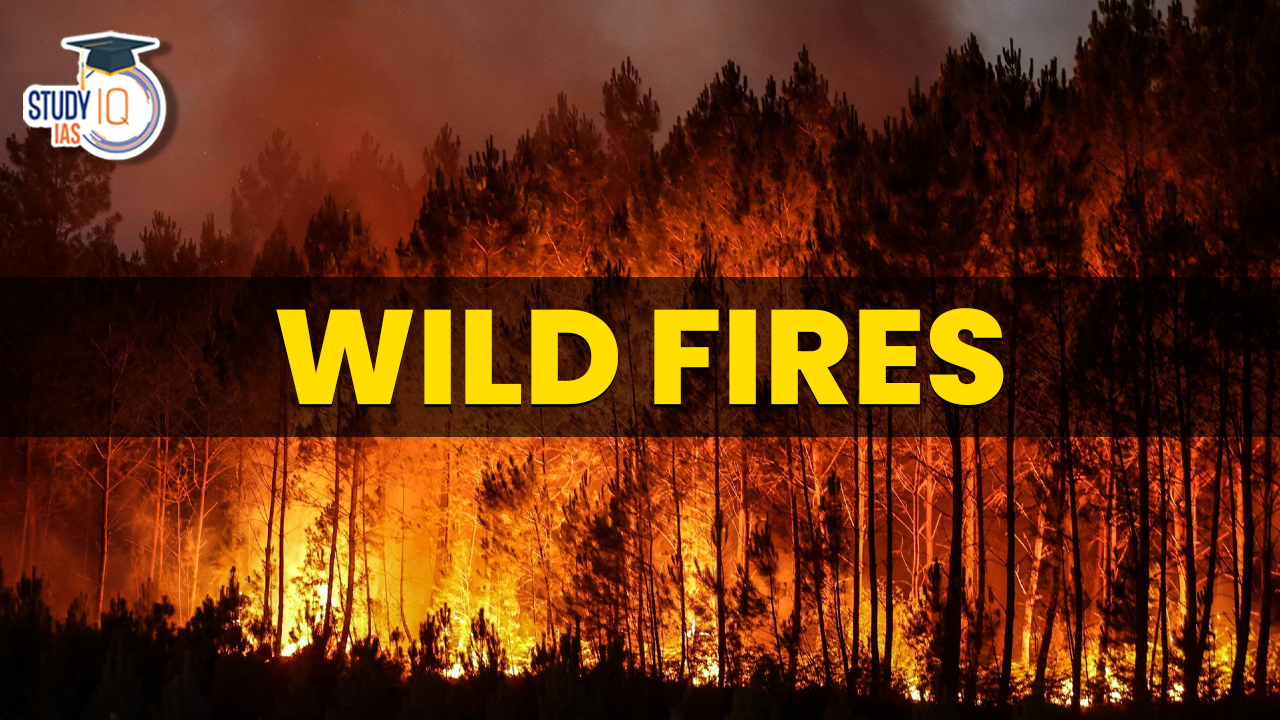Table of Contents
Context: For the past one month, wildfires have been rampant in several countries including Canada, China, Croatia, Greece, Portugal, Spain, Syria, the U.S. (Hawaii and Washington), and Turkey.
What are Wild Fires?
- Wildfires, also known as forest fires or bush fires, are an unplanned, uncontrolled and unpredictable fire in an area of combustible vegetation.
- Wildfires are both natural and man-made. They are sometimes a way of regulating native vegetation, animals, and ecosystems.
Various Reasons for Occurrence of Wild Fires
| Natural Causes | Anthropogenic Causes |
|
|
Connection between Climate change and Wild Fires
- Global warming: Climate change and global warming has increased temperatures, leading to longer dry spells. This facilitates drying of vegetation, making them vulnerable.
- Decline in duration of rainy season: Even though the intensity of rains has increased, it is concentrated within a short period. Increase in dry season has allowed vegetation to turn into tinder box.
- Increase in lightning: Studies have indicated that there will be more frequent incidences of lightning due to climate change. Such lightning incidents can trigger forest fires.
- Heatwaves: Heatwave incidents have drastically increased across the world because of climate change. Heatwave conditions are optimal for forest fire incidents.
Tackling Wild Fires
- Controlled burning: Vulnerable areas must be mapped and preemptively burnt in a controlled manner. This will save larger areas that may have been burnt in case of forest fires.
- Water buffers: Water channels must be constructed within large parcels of vulnerable land (especially grasslands and shrubs) to prevent spread of fires.
- Awareness creation: Forest dwelling communities must be sensitized about the effects of intentional burning. Reducing human-caused ignitions may be the most effective means of reducing unwanted wildfire.
- Stringent laws: Stringent laws must be introduced that penalizes intentional forest fires. This can act as a deterrent against such actions.
India State of Forest Report (ISFR) 2021
- More than 36% of India’s forest cover is vulnerable to frequent forest fires, 6% is ‘very highly’ fire-prone, and almost 4% is ‘extremely’ prone.
- The normal season of forest fires extends from November to June, and majority of fires are caused by man-made factors.
- Madhya Pradesh saw the highest number of fire incidents, followed by Chhattisgarh, Maharashtra, Odisha and Andhra Pradesh, between November 2021 and June 2022.
Forest Fire Management under National Forest Policy
- The policy aims to prepare a strong data base / network on forest fires and evolve an appropriate method to deal with the forest fire situation in more effective manner.
- Under the policy, an Early Warning Fire Forecasting System utilizing satellite data and Fire Danger Rating System for early detection of forest fire has been introduced.
- Some actions suggested under the policy:
- Preventive actions: A preventive program consisting of zoning, danger rating, early warning and real time monitoring must be developed and implemented.
- Inter-agency coordination: Forest department needs to coordinate with National Remote Sensing Agency, Forest Survey of India, the Meteorological Department, the All-India Radio and the State-owned television to plan their actions in the fire season.
- Increase vigilance: Vigilance must be increased in vulnerable areas. For that adequate number of firewatchers must be appointed.
- Communication network: Accessibility to vulnerable areas must be enhanced so as to enable quick transport of human and materials from one area to another.
- Awareness campaign: An awareness campaign involving schools, Joint Forest Management (JFM) committees, NGOs and other groups must be initiated to handle fire damage, prevention, detection and communication and suppression.
- Training: Training must be provided to fire managers, including trainers at JFM unit levels. This will empower them to take effective actions during forest fires.


 Micrometeoroids: Tiny Space Particles, M...
Micrometeoroids: Tiny Space Particles, M...
 India Needs a National Insolvency Tribun...
India Needs a National Insolvency Tribun...
 Unlocking the Potential of India–Afric...
Unlocking the Potential of India–Afric...

























